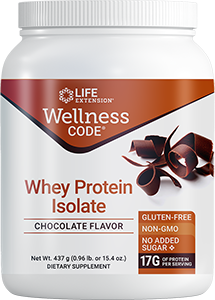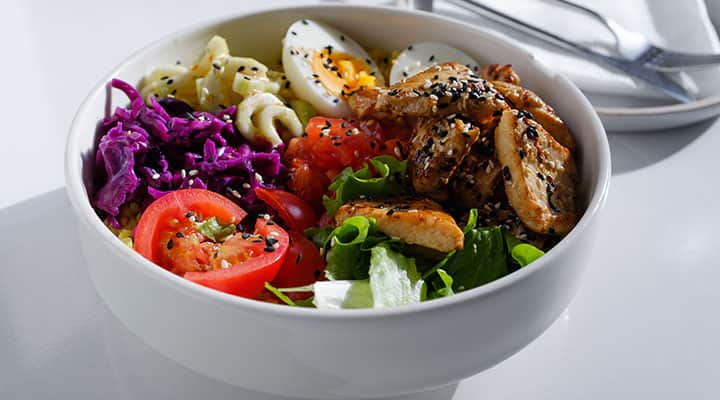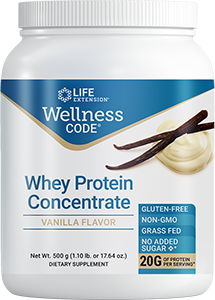
Does Protein Pacing and Intermittent Fasting Help with Weight Loss?
Published: August 2024
It's what's on the inside that counts, right? This is as true for food as it is for people—especially if your goal is weight loss or building lean muscle mass. You can eat fewer calories than your body burns (aka create a calorie deficit), but what's inside those calories and the time of day you eat them can influence your weight and body composition more than anything else.
This is why two strategies, protein pacing and intermittent fasting, have gained quite a following among the lose-weight-and-keep-it-off crowd.
Any registered dietitian will tell you that improving the composition of your meals is the most effective way to improve your health. And protein pacing with intermittent fasting, a combination of two eating patterns, is just one of those nutrition strategies.
Protein pacing with intermittent fasting focuses on eating high-quality, protein-rich meals at regular intervals throughout the day. It also involves changing the composition of your food, so you get the right mix of protein, fat and carbohydrates at every meal and snack.
To better understand how these two lifestyle choices work together, let's take a look at them individually first.
What is protein pacing?
Protein pacing involves eating four to six high-protein meals per day, spaced out every three hours. This well researched dietary pattern is popular among many for how it supports a healthy weight. Research has even found that protein pacing enhances weight loss and body composition, and can help favorably maintain those changes over the course of a year.
Better yet, there's even evidence that this diet can support heart health, too! When investigating the benefits of protein pacing against a traditional heart-healthy diet, research found comparable benefits in relation to healthy blood lipid levels, healthy insulin response and other important heart health biomarkers.
All that is to say, incorporating protein pacing into your lifestyle can offer long term benefits when it comes to your health.
What is intermittent fasting?
Intermittent fasting (IF) involves regularly alternating between eating periods and fasting periods. Like the protein-pacing diet, IF has a strategic timing component. However, there are several different ways to schedule your fasting and eating periods:
- Eight-hour IF: Many people following IF will fast for 16 hours every day, leaving only an eight-hour eating window, sometimes called the 16:8 method.
- 24-hour IF: Others prefer alternate-day fasting, which involves fasting for 24 hours and eating regularly on alternate days.
Several studies suggest that intermittent fasting can promote a healthy body weight and waist circumference and support already-healthy blood glucose and triglycerides levels. Pro tip: Though more research is needed, it looks like alternate-day fasting may be more beneficial than the 16:8 method, with research finding more favorable effects on body weight and BMI compared to time-restricted fasting. Also, it may be beneficial to learn what to eat after fasting.
Why should you combine intermittent fasting with protein pacing?
Protein pacing and IF are well-studied strategies for maintaining a healthy weight, with each demonstrating proven results in multiple studies. So why not just do one or the other? That's indeed an option, but when you combine protein pacing with an intermittent fasting diet, you get consistent protein intake during a time-restricted eating window.
This means you get the benefits of both eating strategies: weight loss, healthy insulin response and long-term weight maintenance. Studies suggest this combination is even better than simply reducing your total calorie intake and feeling deprived every day.
In fact, in an eight-week study, participants followed either an intermittent fasting diet with protein pacing (IF-P) or a heart-healthy calorie-restricted (CR) diet. Their weekly calorie and physical activity levels were approximately the same, but their results were notably different.
The IF-P group achieved greater reductions in weight, total body fat and visceral fat, plus less desire to eat (greater satiety), compared to the CR group.
4 ways to combine protein pacing with intermittent fasting
It can certainly be a challenge to eat enough protein when your eating window is only a few hours. But fear not! There are ways to ensure that you're able to get enough, even under time restrictions.
Break your fast with a high-protein meal
—Whether you call it "breakfast" or not, your first meal of the day literally breaks your fast and opens your eating window. This is your opportunity to get started on the right foot. Researchers have actually studied the metabolic effects of a high-protein breakfast.Plan out your meals ahead of time
—Benjamin Franklin once said, "If you fail to plan, you plan to fail." Knowing what you'll eat and when eliminates a lot of daily stress, because it's one less decision you have to make when you're crunched for time.Meal prep the food you need most
—Planning your meals doesn't have to mean spending your entire Sunday in the kitchen. Instead, decide on which meal(s) you need most and focus on preparing enough of that.Lean on protein supplements
—Another thing you can quickly grab on-the-go? Protein supplements. Give yourself the break you deserve by using protein powders, protein bars and other protein supplements to fill in when you need a helping hand. A smoothie made with protein powder and whole fruits is actually one of the best ways to break a fast.
One randomized controlled trial found that eating a high-protein breakfast supported healthy glucose metabolism after breakfast, lunch and dinner. The caveat: eating breakfast but skipping lunch offsets the good effects. All the more reason to make sure you're getting at least three high-protein meals per day.
Meal planning is a lot like picking out your clothes the night before—and almost as easy. The key is to utilize tools that are at your disposal. For instance, busy families may like having a dry erase board in the kitchen, where you can brainstorm and post the week's menu ideas.
But if you need something more advanced, try creating a Pinterest board or using a meal-planning app that allows you to collect and categorize recipes.
For instance, if you're always rushing in the morning, you would probably benefit from having a high-protein breakfast made ahead of time. Something like overnight oats or a homemade breakfast sandwich you can quickly grab and get out the door.
Other benefits of combining IF and protein pacing
A healthy weight isn't the only benefit of combining intermittent fasting with protein pacing. This approach can also benefit your gut health.
The microbiome diversity—or mix of beneficial bacteria—in your gut is important for your overall health. While many people know that consuming pre- and probiotics in food or supplement form is an effective way to support gut microbiome diversity, surprisingly, though, that's not the only way. So, it should be no surprise that yes, there is a strong connection between gut microbiome and body composition. And your eating patterns can impact both.
One study evaluated the effects of two different diets on gut microbiome: intermittent fasting with protein pacing (IF-P) versus calorie restriction (CR). The results? Intermittent fasting with protein pacing favorably influences gut microbiome dynamics more so than calorie restriction alone.
In fact, participants following the intermittent fasting with protein pacing protocol reported significant relief in overall GI discomfort compared to CR, largely attributed to their increased protein and lower sugar intake. Talk about a gut check!
How Much Protein Do I Need to Eat Daily?
Whether you're an everyday gym rat, or just trying to keep your nutrition in check, upping the overall amount of protein in your diet can benefit anyone. Exactly how much protein you should aim for though when practicing protein pacing is different for everyone and largely depends on your body weight, though age and activity level are also considerations.
Although the current RDA for protein is 0.8 grams per kilogram of body weight per day, many health experts agree this number may fall short. For protein pacing, research recommends approximately 0.3 grams of protein per kilogram of body weight per meal, or 1.4 to 2.0 grams of protein per kilogram of body weight throughout the entire day. For example, this would mean that a 150-pound person (68.2 kilograms) should aim for at least 20 grams of protein per meal or 95 to 136 grams of protein total per day.
And, yes, the type of protein you eat matters. This diet emphasizes high-quality protein sources, such as grass-fed dairy products, wild fish and free-range eggs. When these types of whole foods are not easily accessible, high-quality protein powders and bars can also fit the bill.
Explore Our Best Weight Management Supplements
What are the best protein meals for intermittent fasting?
You've seen the research and have all the information. The hardest part is putting it all together, but don't worry. When you're ready to create these high-protein meals, simply follow these three easy steps:
1. Choose your protein sources according to your goals
Remember, you need at least 1.4 to 2.0 grams of protein per kilogram per day. Calculate your daily protein goals and divide that number by five. That's how much protein you need at each meal.
More than likely, your protein intake will fall between 20 and 40 grams per meal. Use the table below to help you choose the best high-quality protein foods.
| HIGH-PROTEIN FOODS | |||
|---|---|---|---|
| 20 grams | 30 grams | 40 grams | |
| Lean ground beef | 3 ounces | 4.25 ounces | 6 ounces |
| Pork chop | 4 ounces | 5 ounces | 6.7 ounces |
| Chicken breast (boneless, skinless) | 3 ounces | 4.5 ounces | 6 ounces |
| Turkey breast (boneless, skinless) | 2.33 ounces | 3.5 ounces | 4.7 ounces |
| Salmon fillet | 3 ounces | 4.25 ounces | 6 ounces |
| Tuna steak | 3 ounces | 4 ounces | 6 ounces |
| Canned tuna (drained) | 3 ounces | 4 ounces | 6 ounces |
| Whole egg | 3 eggs | 5 eggs | 6½ eggs |
| Liquid egg whites | ¾ cup | 1⅛ cups | 1½ cups |
| Cottage cheese | ¾ cup (170 g) | 1⅛ cups (260 g) | 1½ cups (340 g) |
| Greek yogurt (plain, low-fat) | 7 ounces | 10.5 ounces | 14 ounces |
| Black beans (cooked) | 1⅓ cups | 2 cups | 2⅔ cups |
| Chickpeas | 1½ cups | 2½ cups | 3⅓ cups |
| Lentils, cooked | 1 cup | 1¾ cups | 2⅓ cups |
| Peas | 2½ cups | 3¾ cups | 5 cups |
| Tofu | 2 cups | 3 cups | 4 cups |
| Quinoa, cooked | 1½ cups | 2½ cups | 3⅓ cups |
| Oats, cooked | 2 cups | 3 cups | 4 cups |
| Whey protein isolate | 1 scoop | 1¾ scoops | 2⅓ scoops |
2. Round out your meal with vegetables and carbohydrates
A complete and balanced meal will also include non-starchy vegetables and some complex carbohydrates. Even if you're using protein supplements to create one of your five meals, try to pair that protein with vegetables and carbohydrates.
Again, smoothies are useful, because you can easily get everything in one shot. If you prefer to chew your food, overnight oats with protein powder and topped with fruit follow the guidelines, too.
Pro tip: Certain vegetables are also excellent sources of plant-based protein.
3. Dig in!
Congratulations! If you've gotten this far, you have successfully altered the composition of your meals. You're getting more protein and likely eating fewer calories overall. With intermittent fasting, you simply don't have time for any riff-raff.
And thanks to all that filling protein, you probably won't be hungry for extra snacks. So, now all you have to do is chow down and wait for all the healthy benefits coming your way.
References
- Arciero PJ, et al. "Protein-Pacing Caloric-Restriction Enhances Body Composition Similarly in Obese Men and Women during Weight Loss and Sustains Efficacy during Long-Term Weight Maintenance." Nutrients. July 2016. https://www.ncbi.nlm.nih.gov/pmc/articles/PMC4997389/
- Chair SY, et al. "Intermittent Fasting in Weight Loss and Cardiometabolic Risk Reduction: A Randomized Controlled Trial." J Nurs Res. February 2022. https://pubmed.ncbi.nlm.nih.gov/35050952/
- Mohr AE, et al. "Gut microbiome remodeling and metabolomic profile improves in response to protein pacing with intermittent fasting versus continuous caloric restriction." Nature Communications. May 2024. https://www.nature.com/articles/s41467-024-48355-5
- Xiao K et al. "Effect of a High Protein Diet at Breakfast on Postprandial Glucose Level at Dinner Time in Healthy Adults." Nutrients. December 2022. https://www.ncbi.nlm.nih.gov/pmc/articles/PMC9824806/
- Yang X, et al. "Effect of an Intermittent Calorie-restricted Diet on Type 2 Diabetes Remission: A Randomized Controlled Trial." J Clin Endocrinol Metab. May 2023. https://pubmed.ncbi.nlm.nih.gov/36515429/
Like what you read?
Please subscribe to get email updates on this blog.












